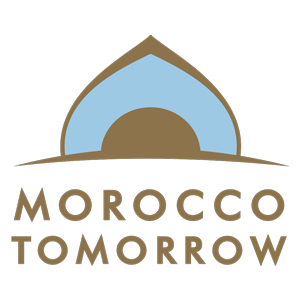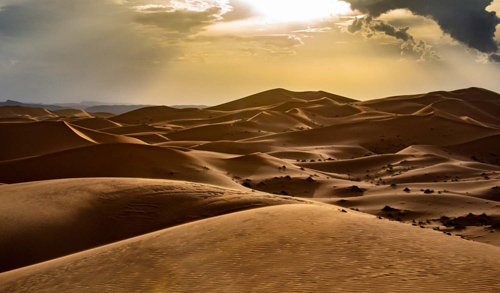A trip to central and south Morocco.

Monkeys, pre-Sahara, Middle Atlas Azrou and a stormy sky over Midelt.
“What is that feeling when you’re driving away from people and they recede on the plain till you see their specks dispersing? – it’s the too-huge world vaulting us, and it’s good-bye. But we lean forward to the next crazy venture beneath the skies.” –Jack Kerouac
Tuesday morning I sat on the top of a dune in the Sahara desert and watched the sun rise over the horizon, only the silhouette of a camel caravan blocking my view of the new day. Not a bad way to wake up. Magic moments like these were pretty standard last week, while our program traversed Morocco on a six-day road trip exploring the middle and south of Morocco. The trip, though whirlwind with a new destination every night, was a much-needed break from the hustle and bustle of Rabat. From the rocky mountain town of Azrou to the sleepy patchwork medina on the beach ofEssaouira, taking the country by road quickly proved that Morocco is an even more diverse nation, geographically and circumstantially, than I could have imagined. In that first day of driving, I saw more changes in scenery than I have in 21 years living in the United States. A half hour driving away from the Atlantic coast, the suburbs eased into rolling farmland that wouldn’t have looked out of place on the Megabus ride through Wisconsin. Soon after that however, the earth cracked, rocky peaks pushed out of the ground and we drove up into the Middle Atlas Mountains. After mapping the small town of Azrou (built into the side of the mountain with calf-muscle toning 45-degree streets), and a three-course lunch featuring a chicken and sheep testicle brioche (hey- when in Morocco, right?), we headed to the cedar forest for the first highlight of the trip: hanging out with Barbary Macaques in the Ifrane National Park. However, as became a pattern on the trip, it is tough to enjoy anything without accidentally contributing to a larger problem. Barbary Macaques are endangered monkeys found in Morocco, Algeria and Tunisia. Due to deforestation of their largest natural habitat, the cedar forest of the Middle Atlas Mountains, and being kidnapped into the pet smuggling trade, the Macaques are dwindling in numbers. However, because the cedar forest is being deforested, the monkeys are overgrazing which is contributing to the endangerment of this forest. An endangered species contributing to the endangerment of an endangered habitat? Welcome to the strange world that is Morocco. There have been conservation efforts made for both the monkeys and trees, but experts worry the actions are too little too late. We stopped in a section of the forest where many tourists stop to take photos with the monkeys, who have become very used to human interaction. Walking into the forest was like stepping across the fence in a zoo: monkeys swung around our heads, grabbed food from our hands and went about their daily business as we snapped countless photos. On one hand, it was really cool to be that close to a wild animal, especially one as adorable as the Barbary Macaque. On the other hand, it was hard not to feel like this closeness was unnatural, especially when you see a monkey chomping away at a candy bar or leftover trash. Researchers have also proven that humans being this close to monkeys can cause them anxiety, and the best way to interact with the monkeys is to sit still in their presence so they forget you are there. With tourists constantly coming and going as a stop on a larger trip (ourselves included) however, it was hard to get a sense of calm in this section of the forest. We ended the night in a five-star hotel with a pool, a welcome break from the bucket shower and shared room of my homestay. The next morning we ventured to Merzouga, a village that serves as a port of entry for most people heading to the Sahara Desert. After chowing on somemedfouna, or “Moroccan pizza” (sausage, onion and cheese stuffed in a crispy bread baked in the ash of a wood burning fire), and being outfitted with headscarves to protect from the sandy desert winds, we boarded 4-wheel drive jeeps and headed to the edge of the Sahara. To say it was a rough trip would be an understatement. Four wheels were barely enough to carry us across the rugged and rock-ridden terrain without popping a tire (though a tire did pop on our way back). Slowly, however, the rough road gave way to rocky plains, which grew sparse as we continued toward the desert. Finally, in the distance beyond the flat pre-desert expanse rose the hazy gold dunes of the Sahara Desert. It was surreal to be in this place I heard so much about my entire life in textbooks, on maps, in clichés (“drier than the Sahara Desert!”) and literally be on its edge: the golden-orange sand abruptly rose from rocky plain to 50 foot dune in about 100 yards. The Sahara Desert is one of the driest and sunniest spots in the world, and gets less than 4 inches of rain per year in the wettest parts of the region. However, as we climbed onto our camels and took off into the desert, the sky was overcast and a steady rainfall had begun. At first, this was obviously disheartening, but when we made it to the top of a 100 foot dune and took in the vast expanse stretching out beyond us, we all agreed there is little that can ruin riding camels in the Sahara Desert. And besides– how many people can say they have been in the Sahara when it has rained? After clomping (I am not sure how else to describe the lilting stomps of a camel) about 45 minutes into the desert, we got off and frolicked up and down the dunes, somersaulting, running, cartwheeling and letting the soft sand cushion our tumbles. It was euphoric to say the least. After returning from our camel rides, we all took a welcome hot shower and settled in the gorgeous Auberge du Sud for the best meal I have had in Morocco thus far (no offense to my host mother). A piping hot buffet of lentils, cous cous, chickpeas, carrots, dates, chobbes (round bread), pasta, potatoes and more, each with a distinct spice and flavor I have never tasted before. The day would have been perfect had it ended there, but it was far from over. We knew we were spending the night in tents and hearing Gnawa music (a music style created by from sub-Saharan slaves going through Morocco in the slave trade era), but I assumed the tents would be classic bare-bones camping style and the music in a formal concert setting. Luckily, I was wrong on both accounts. The tents were nicer than the hotel we stayed at for orientation week, with Persian rugs covering the rough desert ground, tents draped in lush fabrics and mattresses covered in thick patterned blankets. The only reminder that we were actually in the desert was the dung beetle perched on my friend’s pillow. In the middle of these tents, a hole in the carpets was left open for a roaring bonfire. Then the Gnawa music began. This music is characterized by driving percussion, anchored by the clashing krakebs, meant to hearken the sounds of slave shackles walking across the desert. It is then layered by chanting verse and melodious pluckings on the three-string hajhuj, looked to by American jazz and rock and roll artists for inspiration since the 1960’s. We started out quietly sitting around the fire enjoying the music, but thanks to the coaxing of the musicians we ended up dancing and playing the hypnotic beats of Gnawa music. After the concert ended, the Sahara outside our tents beckoned. Would you leave the largest desert in the world unexplored if it lay at your feet? We headed out into the dunes, exploring the shadowy peaks and valleys only lit by our flashlights and rays of moonlight through the dissolving rainclouds above. When the clouds broke, it was like some celestial hand had smeared a layer of glitter across the silky black sky. Shooting stars flashed beside textbook-clear constellations, while the moon dotted the corner like a stamp on the most awe-inspiring envelope ever. Only hours later, we rose to see the sunrise, the sky ombre dissolving from black night with silver stars behind us to the gold morning with neon pink clouds in front of us. We left that day having one of the best experiences of Morocco thus far, but also the most eye opening. This first leg of the journey was an introduction to how the tourism industry functions in Morocco. Tourism makes up ten percent of Morocco’s GDP, and a majority of those tourists come from Europe and America. Quantitative aside, from my observations “exotic” is what sells Morocco. Being in fancy tents, buying headscarves for the desert and sitting on camels guided by men in traditional blue Saharan robes definitely played into this commercialized ideal of Morocco as an exotic locale saturated in ancient traditions, and were unsurprisingly populated by tourists. This was a change for our group: after a month living in the decidedly unglamorous (though still fascinating) Rabat medina, most of our group had seen past the façade of Moroccan exoticism. Its modern culture is leaning toward a western future more so than a traditional North African past. And unsurprisingly you don’t see many tourists oohing and aahing over the pirated DVDs on Rue Souika. We also began to experience the effect of this industry. We passed by five or six similarly elaborate auberges on our way to Auberge du Sud, our desert guides sat each of us down after the camel ride and attempted to sell us fossils and other Saharan trinkets to supplement their low guide income, and one of the Gnawan percussionists yawned as he performed a song that traditionally drives its performer into a spirit-purifying trance. Tourism may be driving the local economy, but at what cost to tradition? It became a question we became more aware of and implicit in as the trip continued. To be continued…
.




